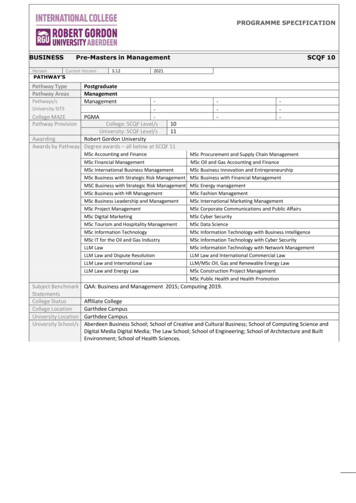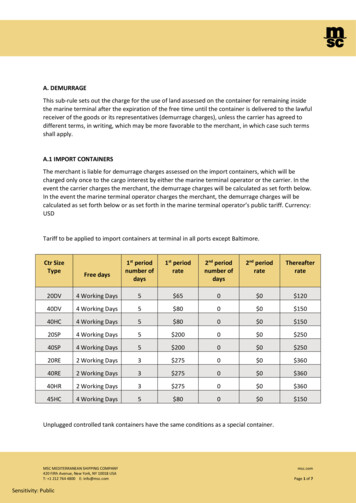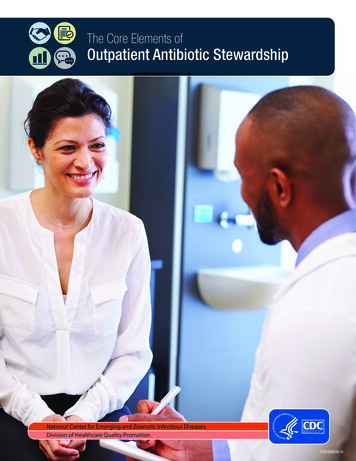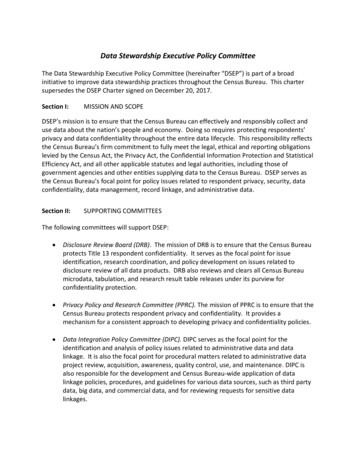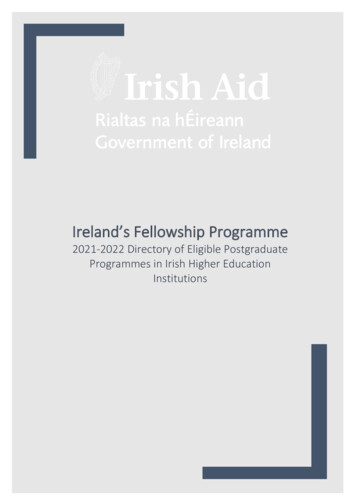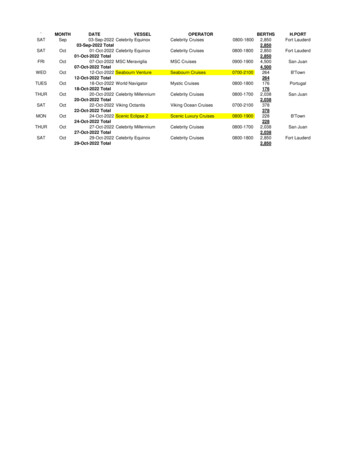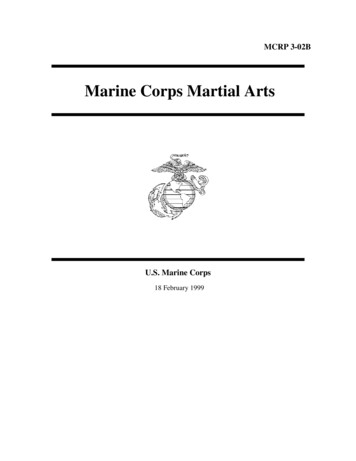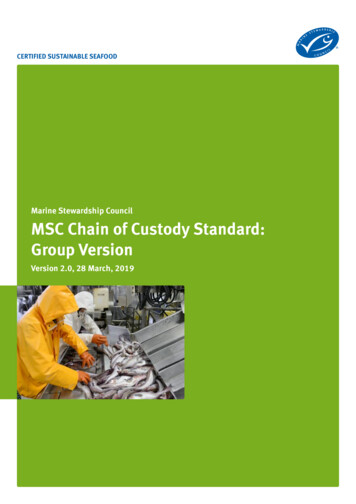
Transcription
CERTIFIED SUSTAINABLE SEAFOODMarine Stewardship CouncilMSC Chain of Custody Standard:Group VersionVersion 2.0, 28 March, 2019
Marine Stewardship CouncilChain of Custody Standard: Group Version v2.0About the Marine Stewardship CouncilVisionOur vision is of the world’s oceans teeming with life, and seafoodsupplies safeguarded for this and future generations.MissionOur mission is to use our ecolabel and fishery certification programto contribute to the health of the world’s oceans by recognising andrewarding sustainable fishing practices, influencing the choices peoplemake when buying seafood, and working with our partners to transformthe seafood market to a sustainable basis.Copyright NoticeThe Marine Stewardship Council “MSC Chain of Custody Standard: GroupVersion” and its content are copyright of “Marine Stewardship Council” “Marine Stewardship Council” 2019. All rights reserved.The official language of this Standard is English. The definitive versionis maintained on the MSC website (msc.org). Any discrepancy betweencopies, versions or translations shall be resolved by reference to thedefinitive English version.The MSC prohibits any modification of part or all of the contents in anyform.Marine Stewardship CouncilMarine House1 Snow HillLondon EC1A 2DHUnited KingdomPhone: 44 (0) 20 7246 8900Fax: 44 (0) 20 7246 8901Email: standards@msc.org2
3Marine Stewardship CouncilChain of Custody Standard: Group Version v2.0Table of ContentsChain of Custody Standard: Group VersionPrinciple 1Certified products are purchased from certified suppliers6Principle 2Certified products are identifiable7Principle 3Certified products are segregated9Principle 4Certified products are traceable and volumes are recorded10Principle 5The organisation’s management system addresses therequirements of this Standard125.1 Management and training125.2 Reporting changes135.3 Subcontractors, transport and contract processing145.4 Non-conforming product155.5 Requests for traceability and supply chain assurance175.6 Specific requirements for under-assessment product185.7 Specific requirements on forced and child labour19Additional requirements for Group CoC206.1Group control206.2Site register and adding new sites216.3Use of the ecolabel, logo, and other trademarks226.4Internal audits236.5Internal group reviews25Principle 6
Marine Stewardship CouncilChain of Custody Standard: Group Version v2.04IntroductionResponsibility for this StandardThe Marine Stewardship Council (MSC) isresponsible for this Standard.Readers should verify that they are using thelatest copy of this and other related documents.Updated documents, together with a master listof all available MSC documents, can be foundon the MSC website (msc.org).Versions publishedVersion No.DateDescription ofamendment1.020 February2015First publication2.028 March 2019Major reviewof CoC GroupStandard.Inclusion of newrequirements onlabour practices(on-shore),and othersubstantive andnon-substantivechanges.About this documentThis document contains mandatoryrequirements for supply chain organisationsseeking MSC Chain of Custody (CoC)certification. Non-mandatory guidance hasbeen developed to help interpret and apply therequirements in this Standard.Chain of Custody certificationCoC certification provides credible assurancethat products sold with the MSC ecolabel ortrademarks originated from a certified fisheryand can be traced throughout the supply chainto a certified source. Organisations certifiedagainst the CoC Standard are audited by a thirdparty accredited certification body, and aresubject to periodic surveillance audits over thethree-year period of a CoC certificate.Use of the MSC Chain of Custody Standard byother standard-setting organisationsThe CoC Standard is made available for use byselected organisations that operate certificationschemes. At the time this Standard was issued,the Aquaculture Stewardship Council (ASC) haselected to use the CoC Standard for all certifiedseafood products originating from ASC-certifiedfarms. This allows supply chain organisationsto handle both MSC certified and ASC certifiedseafood with a single CoC audit, althoughseparate CoC certificates are issued, and eachstandard has distinct trademarks. If othercertification schemes choose to also use theCoC Standard in the future, this information willbe published on the MSC website.Scope and options for Chain of CustodycertificationAny organisation trading or handling productsfrom a certified fishery or farm is eligible tohave CoC certification. CoC certification isa requirement for each organisation in thesupply chain taking legal ownership of certifiedproducts that wishes to make a claim on thecertified source, up until the point whereproducts are packed into consumer readytamper proof packaging.The MSC owns the MSC Chain of CustodyStandard: Default Version and two variants: theMSC Chain of Custody Standard: Group Versionand the MSC Chain of Custody Standard:Consumer-Facing Organisation Version. Furtherinformation on eligibility for each variant canbe found in Section 6.2 of the MSC Chain ofCustody Certification Requirements and in theintroduction to each document.Scope of CoC Standard: Default VersionThis Standard is applicable to any organisationthat has a single site (physical location)handling or trading certified products. The MSCChain of Custody Standard: Default Version(CoC Default Standard) is also applicable forany organisation that has numerous siteshandling certified products, but where each siteis individually audited against the CoC DefaultStandard. In this case a single certificate will beissued, called a multi-site certificate. Examplesof organisations that might be certified againstthe Default CoC Standard include a singlesite trading organisation, or a processor withseveral factory locations.Some requirements of the CoC DefaultStandard, such as purchasing from certifiedsuppliers, may not apply where theorganisation is a farm or a fishery.Scope of MSC Chain of Custody Standard:Group VersionThe MSC Chain of Custody Standard: GroupVersion (CoC Group Standard) applies toany organisation any organisation handlingcertified products at many sites, whereeach site is not individually audited by theConformity Assessment Body (CAB). This canbe more efficient than multi-site certification
Marine Stewardship CouncilChain of Custody Standard: Group Version v2.05Introduction continuedfor organisations with many sites, or groupsof organisations that join together. Theorganisation designates a central officefunction that establishes internal controlsand is responsible for ensuring that every sitecomplies with the CoC Group Standard. TheCAB audits the central office and a sampleof sites, rather than auditing every site. Asingle CoC code and certificate are sharedacross the group. Examples of organisationsthat might be certified against the CoC GroupStandard include a large wholesaler with manywarehouse locations, or a restaurant chain(having decided not to be certified against theCoC CFO Standard).Some clauses of the CoC Group Standard, suchas purchasing from certified suppliers, maynot apply where the organisation is a farm or afishery.CoC Standard: Consumer-FacingOrganisation (CFO) VersionThe MSC Chain of Custody Standard: ConsumerFacing Organisation Version (CoC CFO Standard)applies to any organisation that serves or sellsseafood to the final consumer and meets otherspecific eligibility criteria. Consumer-facingorganisations (CFOs) such as retail or foodservicecan be single sites or have numerous locations,and a single CoC code is issued for all sites underthe organisation’s management system thathandle or trade certified products. Similar to theCoC Group Standard, the CAB audits a sampleof the total number of sites in the certificate.Examples of CFOs include restaurants, restaurantchains, fishmongers, retailers with fish counters,and caterers.Eligibility for MSC Chain of CustodyStandard: Group VersionOrganisations are eligible to be certified againstthe Group version of the CoC Standard only if allthe following criteria are met:a.The proposed group’s centraloffice is a legal entity with whom acontract can be made.b.All sites undertake substantially similaractivities as defined by MSC Chain ofCustody activities, or if they do not, thegroup can be stratified for sampling.c.The entire group operation is within asingle geographic region, or if they arenot, the group can be stratified forsampling.d.The same written language is used at allsites and can be read by all site managers,or if translations are provided, adequatedocument control procedures are in placeto ensure version consistency acrossdifferent languages.e.f.The proposed group’s central officeis capable of objectivity in audit anddecision making.The proposed group’s central officecan demonstrate through theirapplication an understanding of theCoC Group Standard such that it islikely that they will be able toqualify for certification.Note: Some organisations will be eligible touse the Default, Group and/or CFO version ofthe CoC Standard. Organisations are advisedto check their eligibility against all CoCcertification options (i.e. Default, Group, CFO)available in Section 6.2 of the MSC Chain ofCustody Certification Requirements beforediscussing the best option with their CAB.Effective dateThe effective date for version 2.0 of the CoCGroup Standard is 28 September 2019. Allaudits against the CoC Group Standard thatstart on or after this date shall use this version.Review dateThe MSC welcomes comments on this Standard.Comments will be considered as part of the nextreview process. Reviews will take place at leastevery five years. Please submit comments tostandards@msc.org. More information about theMSC policy development process and the MSCStandard Setting Procedure can be found on theMSC website (msc.org).Normative documentsThe documents listed below contain provisionsthat, through reference in this text, becomepart of this Standard. For documents listed,the latest published edition of the documentapplies.a.MSC Chain of Custody CertificationRequirements.b.MSC-MSCI Vocabulary.c.MSC Third-Party labour AuditRequirements.d.CoC Certificate Holder Statement ofUnderstanding of Labour Requirements.e.MSC ecolabel user guide.Terms and definitionsConcepts, terms and phrases are defined in theMSC-MSCI Vocabulary.
Marine Stewardship CouncilChain of Custody Standard: Group Version v2.06Principle 1Certified products are purchased from certified suppliers1.1The organisation shall have a process in place to ensure that all certified products arepurchased from certified suppliers, fisheries, or farms.Guidance 1.1Certified products refer to any seafood that originates from certified fisheries or farms and isidentified as certified.This excludes seafood products in “consumer ready tamper proof” packaging (i.e. sealed andlabelled products that will be sold to final consumers in the same form, such as individualcans of tuna). For a full definition of “consumer ready tamper proof”, refer to Section 6.1 ofthe MSC Chain of Custody Certification Requirements (CoCCR).For the purposes of Chain of Custody (CoC), a “supplier” is an entity that is named on thesales documentation that demonstrates transfer of legal ownership from seller to buyer andrelates to certified product. In most cases, this proof of purchase will be an invoice, but couldalso be demonstrated through a contract or deed.The organisation’s process will need to include verifying that the party which they takelegal ownership of the product from has the relevant valid certification. If buying direct fromanother supplier, this will be a valid CoC certificate. If buying direct from a fishery or a farm,the process needs to include: Verifying that the fishery or farm has a valid fishery or farm certificate. Checking the fishery assessment or farm audit report and, if the report specifies that thefishery or farm is required to have CoC certification, verifying that the fishery or farm alsohas a valid CoC certificate.The certified status of MSC supply chain companies and fisheries can be verified on the MSCwebsite (msc.org), and ASC supply chain companies and farms on the ASC website (ascaqua.org). These websites are more accurate than relying on paper certificates, which may becancelled, suspended or withdrawn before expiring.1.2Organisations handling physical products shall have a process in place to confirm thecertified status of products upon receipt.Guidance 1.2Documentation received with certified products needs to clearly identify the product ascertified. This could include delivery notes, invoices, bills of lading, or electronic informationfrom the supplier. This identification is to help ensure that if a supplier replaces certifiedseafood with non-certified seafood (e.g. if stock runs out), this will be detected by thereceiving organisation.If a supplier uses an internal system (such as barcodes or product codes) to uniquely identifycertified products on documents, the receiving organisation needs to understand thesupplier’s description in order to confirm the product is certified.If associated records do not clearly identify products as certified, it is not sufficient to rely onlyon physical product labelling (e.g. the MSC or ASC label or CoC code on a box) to confirm thecertified status.If receiving products directly from a certified farm, the process may include testing the products forantibiotics or banned substances which cannot be applied to products at the farm if they are to besold as certified, based on the requirements of the farm standard.
Marine Stewardship CouncilChain of Custody Standard: Group Version v2.07Principle 1 continuedCertified products are purchased from certified suppliers1.3Organisations with certified products in stock at the time of the initial certification auditshall be able to demonstrate that these products were purchased from a certifiedsupplier, fishery or farm, and comply with all relevant sections of this Standard beforethey can be sold as certified.Guidance 1.3Certified products in inventory at the time of initial certification will need to be traceableback to a certified supplier, fishery, or farm as per Principle 4. The organisation will alsoneed to demonstrate that any certified product in inventory is identifiable and segregated asper Principles 2 and 3.Principle 2Certified products are identifiable2.1Certified products shall be identified as certified at all stages of purchasing, receiving,storing, processing, packing, labelling, selling and delivering, except for sales invoices tofinal consumers.Guidance 2.1It is recommended that certified products are identifiable as certified on the physical productas well as on the accompanying traceability records. This can be done by placing a sign orlabel on the package, container, or pallet.Organisations can use a variety of methods to identify certified products, including acronyms(e.g. “MSC” or “ASC”), the CoC code, or another internal system of identification.Where it is impossible or impractical to label physical products (e.g. fish in a defrosting tank)the organisation will need to demonstrate how the product can be linked with associatedtraceability or inventory records that specify the certified status.Sales invoices to the final consumer include receipts at restaurants, fishmongers or retail fishcounters. These do not need to include identification of certified items, although the certifieditems will still need to be identified at point of serving (e.g. on the menu or fish counter).
Marine Stewardship CouncilChain of Custody Standard: Group Version v2.08Principle 2Certified products are identifiable2.2If products are sold as certified, they shall be identifiable as certified on the line item ofthe related invoice, unless all products on the invoice are certified, except for salesinvoices to final consumers.Guidance 2.2Identifying certified products on the line item of the invoice can be done in a variety of ways;for example, using the acronyms “MSC” or “ASC” in the product description, using the CoCcode, or using a unique product code that corresponds to a certified product and that hasbeen communicated to customers.If all items on an invoice are certified, it is acceptable to only have certified identification (e.g.the CoC code) at the top of the invoice. This requirement aims to help make it clear to a buyerand to the CAB (Conformity Assessment Body) which products on any given invoice were soldas certified. The acronyms “ASC” and “MSC” can be used for traceability and identificationpurposes without requiring a licence agreement (see 2.4).2.3The organisation shall operate a system that ensures packaging, labels, menus, and othermaterials identifying products as certified can only be used for certified products.2.3.1Certified products shall not be mislabelled by species.Guidance 2.3.1Scientific or common names may be used. The use of species names which are not alignedwith the relevant legislation in the country or countries in which the product is traded isconsidered mislabelling.2.3.2Certified products shall not be mislabelled by catch area or origin, where this is identified.Guidance 2.3.2It is not required to specify catch area or origin on product labels, but where this informationis specified, this clause applies. Catch area and origin identification which is not aligned tothe relevant legislation in the country or countries in which the product is traded is consideredmislabelling.2.4The organisation shall only promote products as certified or use the MSC or ASC label orother trademarks if it has been granted approval to do so under the terms of the licenceagreement (ecolabel@msc.org).Guidance 2.4Use of the acronyms (e.g. “MSC” or “ASC”) or the full name of the standard owner (e.g.“Marine Stewardship Council” or “Aquaculture Stewardship Council”) on products ortraceability records in a purely business-to-business nature to identify products is permittedwithout a licence agreement.Any other use of the MSC or ASC label or other trademarks requires a licence agreement fromMSCI, the MSC’s licensing function for MSC and ASC products.During an audit, the organisation may be asked to show evidence of trademark approvalemails received from MSCI.
Marine Stewardship CouncilChain of Custody Standard: Group Version v2.09Principle 3Certified products are segregated3.1There shall be no substitution of certified products with non-certified products.Guidance 3.1This includes products sold as certified that are not eligible to be sold as certified by thefarm, based on the requirements of the farm standard. These are non-certified even if froma certified farm.Annual volume reconciliations of certified purchases (or production) and sales could beused to support verification that substitution has not occurred.3.2Certified and non-certified products shall not be mixed if the organisation wishes to makea claim about these certified products, except:3.2.1If non-certified seafood is used as an ingredient in certified products, the organisationshall follow the non-MSC/ASC certified seafood ingredients rules.Guidance 3.2.1The non-MSC/ASC certified seafood ingredients rules can be found in the MSC ecolabeluser guide or the ASC logo user guide respectively. These documents can be found onthe MSC website (msc.org) or the ASC website (asc-aqua.org). The rules define wherenon-certified seafood can be used as an ingredient in certified products and the specificrestrictions that apply. The ability to use non-certified seafood and apply these rules is onlyrelevant for licenced MSC and/or ASC labelled products.3.3Products certified against different recognised certification schemes that share the CoCStandard shall not be mixed if the organisation wishes to sell the product as certified,unless:Guidance 3.3This applies to any other standard, such as the Aquaculture Stewardship Council (ASC),that uses the CoC Standard for supply chain traceability.a.The organisation has specific permission from MSCI, orGuidance 3.3.aMSCI may approve a product with ingredients certified to different schemes (e.g. MSC andASC) that may then be co-labelled (e.g. include the MSC and ASC label on pack) and havethe different ingredients identified to the scheme they are certified to (e.g. MSC salmon,ASC shrimp).b.The same product is certified against multiple recognised certification schemesthat share the CoC StandardGuidance 3.3.bThis refers to products which are certified to more than 1 scheme at their origin (e.g. afishery or farm with MSC and ASC certification).
Marine Stewardship CouncilChain of Custody Standard: Group Version v2.010Principle 4Certified products are traceable, and volumes are recorded4.1The organisation shall have a traceability system that allows:a.Any product or batch sold as certified to be traced back from the sales invoice orpoint of serving to a certified supplier.Guidance 4.1.aCompanies at the end of the supply chain, such as restaurants and fishmongers, are onlyexpected to trace back from the point of serving to customers or sale. Historic traceability ofservings or sales to final consumers are therefore not required, but all other traceability steps(e.g. receipts and deliveries to consumer serving sites and handing at non-consumer servingsites) still require historic records as per 5.1.3.All other companies are expected to trace back from the sales invoice.b.Any products identified as certified upon receipt to be traced forward from point ofpurchase to point of sale or serving.Guidance 4.1.b4.1.b does not apply if an organisation receives certified material from a supplier but neveridentifies this as a certified product upon receipt (e.g. if a supplier ships an MSC certifiedproduct but the customer did not order it as certified).Any product identified as a certified item upon receipt needs to be traceable through to finalsale or serving, even if it is not eventually sold as certified.Companies at the end of the supply chain, such as restaurants and fishmongers, are onlyexpected to trace forward from purchase to point of serving to customers at the time it isserved. Historic traceability of servings or sales to final consumer are therefore not required,but all other traceability steps (e.g. receipts and deliveries to consumer serving sites andhanding at non-consumer serving sites) still require historic records as per 5.1.3.All other companies are expected to trace forward from purchase to sale.4.2Traceability records shall be able to link certified products at every stage betweenpurchase and sale, including receipt, processing, transport, packing, storage, dispatchand/or serving.4.3Records of certified products shall be accurate, complete, and unaltered.4.3.1Where records are changed, these changes shall be clearly documented including thedate and name or initials of the person making the changes.Guidance 4.3.1Where information or records provided by the organisation during audits or other requests isnot consistent with information provided at a different point in time, the CAB may issue nonconformities. If records are altered by the organisation to reflect necessary adjustments (suchas returned orders), these changes should be clearly recorded.
Marine Stewardship CouncilChain of Custody Standard: Group Version v2.011Principle 4 continuedCertified products are traceable, and volumes are recorded4.4The organisation shall maintain records that allow volume calculation of certified product.Guidance 4.44.4 applies to any product identified as certified or eligible to be sold with the certifiedtrademarks. If seafood is purchased as certified but then converted to a non-certified status(and will never be sold as certified), then records would only need to show the volumesof product that were converted to a non-certified status. Further volume records (e.g. forsubsequent processing of non-certified items) do not need to be maintained.All records should be maintained for three years as per 5.1.34.4.1Sites selling to or serving the final consumer shall maintain all records of volumespurchased and received.Guidance 4.4.1Records of volumes of products sold or served to final consumers do not need to be recorded.Products sold or served to final consumers need to be traceable at the time of serving (see4.1.a and 4.1.b).4.5If processing or repacking occurs, records shall allow conversion rates for certified outputsfrom certified inputs over any given batch or time period to be calculated.4.5.1Conversion rates for processing of certified products shall be justifiable and accurate.Guidance 4.5.1The intent of this clause is to prevent cases where conversion rates are extremely high or lowand could indicate potential for substitution of certified and non-certified product. Normalfluctuations in conversion rates due to product quality, seasonality, processing efficiency,etc. are expected.To verify cases where conversion rates are potentially allowing room for mislabelled product,the CAB may check records against product specifications, similar products being processed,or the organisation’s historical processing records.4.6The organisation shall only sell as certified the products covered by its scope ofcertification.Guidance 4.6The requirements for changes to scope, which cover new species, activities, or productscertified against other recognised certification schemes that share the CoC Standard are givenin 5.2.1.c, 5.2.2.a, and 5.2.2.b.
Marine Stewardship CouncilChain of Custody Standard: Group Version v2.012Principle 5The organisation’s management system addresses therequirements of this Standard5.1Management and training5.1.1The organisation shall operate a management system that is effective in addressing allrequirements in this Standard.Guidance 5.1.1The management system includes the systems, policies and procedures used to ensurethat the organisation complies with this Standard. The extent of documentation required forthe management system may vary, depending on the size of the organisation, the type ofactivities, the complexity of processes, and the competency of personnel.For very small or straightforward operations, no written documentation may be needed aslong as the responsible staff understand and can implement procedures related to thisStandard.5.1.2The organisation shall ensure that responsible personnel are trained and competent inorder to ensure conformity with this Standard.Guidance 5.1.2“Responsible personnel” refers to individuals within an organisation who are responsiblefor making decisions or carrying out procedures related to this Standard.Most organisations will need to conduct some type of training to ensure that employeesunderstand CoC requirements and follow internal procedures to keep certified productssegregated, identifiable, and traceable. However, for organisations with simple processes,it may be adequate to provide an employee handbook, instructions, and/or posters in foodpreparation areas.5.1.3The organisation shall maintain records that demonstrate conformity with this Standardfor a minimum of 3 years, or for the full duration of the certified product’s shelf life iflonger than 3 years.Guidance 5.1.3Records that demonstrate conformity with this Standard typically include purchase andsale records of certified products, internal traceability and production records for certifiedproducts, and internal procedures or training records. These records may be in hard copy ordigital format.Records of sales and/or servings to the final consumer do not have to be maintained.5.1.4The organisation shall appoint an individual (“CoC contact person” or “group manager”)who will be responsible for all contact with the CAB and for responding to any requests fordocumentation or information related to conformity with this Standard.Guidance 5.1.4If the contact person changes, the CAB needs to be notified as per 5.2.1.
Marine Stewardship CouncilChain of Custody Standard: Group Version v2.013Principle 5 continuedThe organisation’s management system addresses therequirements of this Standard5.2Reporting changes5.2.1The organisation shall inform their CAB in writing or by email within 10 days of thefollowing changes:a.New CoC contact person or group manager within the organisation.b.Certified products received from a new certified supplier, fishery, or farm.c.New certified species received.Guidance 5.2.1Notification by email or writing needs to be sent to the CAB within 10 days of receiving a newcertified species or within 10 days of receiving the first delivery of certified products from anew certified supplier, fishery, or farm.As per the MSC-MSCI Vocabulary, “day” is defined as “calendar day” in this Standard unlessotherwise stated.It is not required to notify the CAB in the case that the source fishery that the organisation’ssupplier (or their supplier) receives the product from changes.5.2.2The organisation shall receive written approval from their CAB before making any of thefollowing changes:a.Undertaking a new activity with respect to certified products that is not alreadyincluded in the scope of certification.Guidance 5.2.2.aNew activities include for example trading, distribution, secondary processing, and storage. Afull list of activities can be found in Table 4 of the CoCCR.b.Extending the scope of CoC to sell or handle products certified against differentrecognised certification schemes that share the CoC Standard.Guidance 5.2.2.bFor example, if the current CoC certificate covers only MSC certified products, the organisationwould need to receive approval from the CAB before selling ASC certified products ascertified.c.Using a new subcontractor that does contract processing or repacking of certifiedproducts.Guidance 5.2.2.cIf the organisation wishes to add a new storage or transport subcontractor, this will need tobe updated on the record of subcontractors as per 5.3, but the CAB can be notified at the
The organisation's management system addresses the requirements of this Standard 5.1 Management and training . 5.5 Requests for traceability and supply chain assurance 5.6 Specific requirements for under-assessment product 5.7 Specific requirements on forced and child labour . Principle 2 Principle 3 Principle 4 Principle 5 Principle 6 6 .

